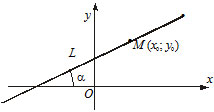A square table $$A=\begin{pmatrix}a_{11}&a_{12}\\a_{21}&a_{22}\end{pmatrix}$$ composed of four real or complex numbers is called a square matrix of the 2nd order.The determinant of the 2nd order corresponding to matrix $A$ (or simply the determinant of matrix $A$) is called the number $$\det A=\begin{vmatrix}a_{11}&a_{12}\\a_{21}&a_{22}\end{vmatrix}=a_{11}a_{22}-a_{12}a_{21}.$$
1) $y = kx + b,$ where $k$ is the slope coefficient, and $b$ is the segment the line cuts off on the $OY$ axis.

2) $y - y_0 = k(x - x_0)$ - the equation of the line passing through a given point $P(x_0, y_0)$ at a given angle $\alpha$ to the $OX$ axis ($k = \tan\alpha$).

A sequence of real numbers is defined as a function $f: \mathbb{N} \rightarrow \mathbb{R}$ defined on the set of all natural numbers. The number $f(n)$ is called the $n$-th term of the sequence $x_n$, and the formula $x_n=f(n)$ is called the general term formula of the sequence $(x_n)_{n\in \mathbb{N}}$.
A number $a$ is called the limit of the sequence $(x_n){n\in \mathbb{N}}$ if for any $\varepsilon>0$ there exists a number $N(\varepsilon)$ such that for $n>N(\varepsilon)$ the inequality $|x{n+p}-x_n|<\varepsilon$ holds. In this case, the sequence itself is called convergent.
Cauchy Criterion.
For a sequence $(x_n){n\in \mathbb{N}}$ to have a limit, it is necessary and sufficient that for any $\varepsilon>0$ there exists a number $N(\varepsilon)$ such that for $n>N(\varepsilon)$ the inequality $|x{n+p}-x_n|<\varepsilon$ holds for any $p\in \mathbb{N}$.
Complex numbers are numbers of the form $x+iy$, where $x,y\in \mathbb{R}$, and $i$ is a number such that $i^2=-1$. The set of complex numbers is denoted by $\mathbb{C}$.
Operations with complex numbers.
Addition of complex numbers:
$$(x_1+iy_1)+(x_2+iy_2)=(x_1+x_2)+i(y_1+y_2).$$
Multiplication of two complex numbers:
$$(x_1+iy_1)(x_2+iy_2)=x_1x_2-y_1y_2+(x_1y_2+x_2y_1)i.$$
A set is understood as any collection of some objects. These objects are called elements of the set. Sets are denoted by capital letters, and elements are denoted by lowercase letters.
The fact that an element $a$ belongs to a set $A$ (i.e., is an element of set $A$) is written as $a\in A$, and the fact that an element $b$ does not belong to set $A$ (i.e., is not its element) is written as $b\notin A$.
A set that does not contain any elements is called empty and is denoted by the symbol $\emptyset$.
The notation $A\subset B$ ($A$ is contained in $B$) means that every element of set $A$ is an element of set $B$; in this case, set $A$ is called a subset of set $B$. Sets $A$ and $B$ are called equal $(A=B)$ if $A\subset B$ and $B\subset A$.
Equations with separable variables.
Equations with separable variables can be written in the form$$y'=f(x)g(y),\qquad\qquad\qquad(1)$$ and also in the form $$M(x)N(y)dx+P(x)Q(y)dy=0.\qquad\qquad\qquad(2)$$ o solve this equation, it needs to be transformed in such a way that one part of the equation involves only $x$, and the other only involves $y$, and then integrate both parts.
When dividing both sides of the equation by an expression containing the unknowns $x$ and $y$, solutions that make this expression zero may be lost.




